- Clone
- MEL-14 (See other available formats)
- Regulatory Status
- RUO
- Other Names
- L-selectin, LECAM-1, Ly-22, LAM-1, MEL-14
- Isotype
- Rat IgG2a, κ
- Ave. Rating
- Submit a Review
- Product Citations
- 4 publications
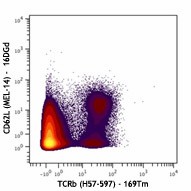
| Cat # | Size | Price | Quantity Check Availability | Save | ||
|---|---|---|---|---|---|---|
| 104443 | 100 µg | 106 CHF | ||||
CD62L is a 74-95 kD glycoprotein also known as L-selectin, LECAM-1, Ly-22, LAM-1, and MEL-14. It is a member of the selectin family and is expressed on the majority of B and naïve T cells, a subset of memory T cells, monocytes, granulocytes, most thymocytes, and a subset of NK cells. CD62L is important in lymphocyte homing to high endothelial venules (HEV) in peripheral lymph nodes and leukocyte "rolling" on activated endothelium. CD62L also contributes to neutrophil emigration at inflammatory sites. CD62L is rapidly shed from lymphocytes and neutrophils upon cellular activation and the expression levels of CD62L (in conjunction with other markers) have been used to distinguish naïve, effector, and memory T cells. CD62L has been reported to interact with CD34, GlyCAM-1, and MAdCAM-1.
Product DetailsProduct Details
- Verified Reactivity
- Mouse
- Antibody Type
- Monoclonal
- Host Species
- Rat
- Immunogen
- C3H/eb mouse B lymphoma 38C-13
- Formulation
- Phosphate-buffered solution, pH 7.2, containing 0.09% sodium azide and EDTA.
- Preparation
- The antibody was purified by affinity chromatography.
- Concentration
- 1.0 mg/ml
- Storage & Handling
- The antibody solution should be stored undiluted between 2°C and 8°C.
- Application
-
FC - Quality tested
CyTOF® - Verified - Recommended Usage
-
This product is suitable for use with the Maxpar® Metal Labeling Kits. For metal labeling using Maxpar® Ready antibodies, proceed directly to the step to Partially Reduce the Antibody by adding 100 µl of Maxpar® Ready antibody to 100 µl of 4 mM TCEP-R in a 50 kDa filter and continue with the protocol. Always refer to the latest version of Maxpar® User Guide when conjugating Maxpar® Ready antibodies.
- Application Notes
-
Additional reported applications (for the relevant formats) include: immunoprecipitation1-3, complement-dependent cytotoxicity4, in vivo and in vitro blocking of adhesion1-3,5, and immunohistochemical staining of acetone-fixed frozen sections and zinc-fixed paraffin-embedded sections6. The Ultra-LEAF™ purified antibody (Endotoxin < 0.01 EU/µg, Azide-Free, 0.2 µm filtered) is recommended for functional assays (Cat. Nos. 104457-104462).
- Additional Product Notes
-
Maxpar® is a registered trademark of Standard BioTools Inc.
-
Application References
(PubMed link indicates BioLegend citation) -
- Gallatin WM, et al. 1983. Nature 304:30. (IP, Block)
- Siegelman MH, et al. 1990. Cell 61:611. (IP, Block)
- Lewinsohn DM, et al. 1987. J. Immunol. 138:4313. (IP, Block)
- Iwabuchi K, et al. 1991. Immunobiology 182:161. (CMCD)
- Pizcueta P, et al. 1994. Am. J. Pathol. 145:461.
- Reichert RA, et al. 1986. J. Immunol. 136:3535. (IHC, FC)
- Olver S, et al. 2006. Cancer Res. 66:571.
- Fukushima A, et al. 2006. Invest. Ophthalmol. Vis. Sci. 47:657. PubMed
- Benson MJ, et al. 2007. J. Exp. Med. doi:10.1084/jem.20070719. (FC) PubMed
- Chappaz S, et al. 2007. Blood doi:10.1182/blood-2007-02-074245. (FC) PubMed
- Lee JW, et al. 2006. Nature Immunol. 8:181.
- Shigeta A, et al. 2008. Blood 112:4915 (FC) PubMed
- de Vries VC, et al. 2009. Am. J. Transplant. 9:2270 PubMed
- Product Citations
-
- RRID
-
AB_2562802 (BioLegend Cat. No. 104443)
Antigen Details
- Structure
- Selectin, 95 kD (neutrophils) or 74 kD (lymphocytes)
- Distribution
-
Subsets of B and T cells, monocytes, granulocytes, subset of NK cells
- Function
- Lymphocyte homing to HEV, rolling on activated endothelium
- Ligand/Receptor
- CD34, GlyCAM-1, MAdCAM-1
- Cell Type
- B cells, Granulocytes, Monocytes, Neutrophils, NK cells, T cells, Tregs
- Biology Area
- Cell Adhesion, Cell Biology, Costimulatory Molecules, Immunology, Innate Immunity
- Molecular Family
- Adhesion Molecules, CD Molecules
- Antigen References
-
1. Barclay AN, et al. 1997. The Leukocyte Antigen FactsBook Academic Press.
2. Kishimoto TK, et al. 1990. P. Natl. Acad. Sci. USA 87:2244.
3. Tedder TF, et al. 1995. J. Exp. Med. 181:2259. - Gene ID
- 20343 View all products for this Gene ID
- UniProt
- View information about CD62L on UniProt.org
Related FAQs
- Can I obtain CyTOF data related to your Maxpar® Ready antibody clones?
-
We do not test our antibodies by mass cytometry or on a CyTOF machine in-house. The data displayed on our website is provided by Fluidigm®. Please contact Fluidigm® directly for additional data and further details.
- Can I use Maxpar® Ready format clones for flow cytometry staining?
-
We have not tested the Maxpar® Ready antibodies formulated in solution containing EDTA for flow cytometry staining. While it is likely that this will work in majority of the situations, it is best to use the non-EDTA formulated version of the same clone for flow cytometry testing. The presence of EDTA in some situations might negatively affect staining.
- I am having difficulty observing a signal after conjugating a metal tag to your Maxpar® antibody. Please help troubleshoot.
-
We only supply the antibody and not test that in house. Please contact Fluidigm® directly for troubleshooting advice: http://techsupport.fluidigm.com/
- Is there a difference between buffer formulations related to Maxpar® Ready and purified format antibodies?
-
The Maxpar® Ready format antibody clones are formulated in Phosphate-buffered solution, pH 7.2, containing 0.09% sodium azide and EDTA. The regular purified format clones are formulated in solution that does not contain any EDTA. Both formulations are however without any extra carrier proteins.
Other Formats
View All CD62L Reagents Request Custom ConjugationCompare Data Across All Formats
This data display is provided for general comparisons between formats.
Your actual data may vary due to variations in samples, target cells, instruments and their settings, staining conditions, and other factors.
If you need assistance with selecting the best format contact our expert technical support team.
-
APC anti-mouse CD62L
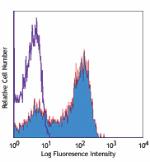
C57BL/6 mouse splenocytes were stained with CD62L (clone MEL... -
Biotin anti-mouse CD62L
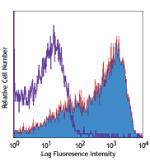
C57BL/6 mouse splenocytes were stained with biotinylated CD6... -
FITC anti-mouse CD62L
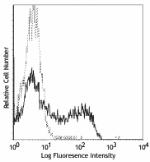
C57BL/6 bone marrow cells stained with MEL-14 FITC -
PE anti-mouse CD62L

C57BL/6 mouse splenocytes stained with MEL-14 PE -
PE/Cyanine5 anti-mouse CD62L

C57BL/6 mouse bone marrow cells were stained with CD62L (clo... -
Purified anti-mouse CD62L
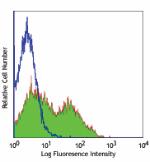
C57BL/6 mouse splenocytes stained with purified MEL-14, foll... 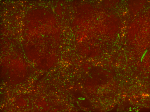
Fresh, frozen mouse spleen was stained with purified CD62L c... -
PE/Cyanine7 anti-mouse CD62L
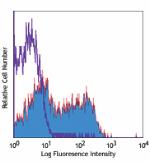
C57BL/6 mouse splenocytes were stained with CD62L (clone MEL... -
Alexa Fluor® 488 anti-mouse CD62L
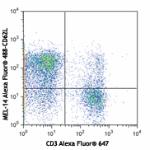
C57BL/6 mouse splenocytes were stained with CD3 Alexa Fluor®... 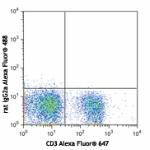
-
Alexa Fluor® 647 anti-mouse CD62L
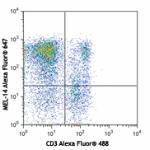
C57BL/6 mouse splenocytes were stained with CD3 Alexa Fluor®... 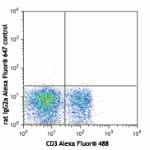
-
Pacific Blue™ anti-mouse CD62L
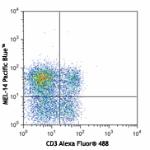
C57BL/6 mouse splenocytes were stained with CD3 Alexa Fluor&... 
-
Alexa Fluor® 700 anti-mouse CD62L
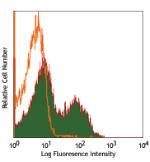
C57BL/6 mouse bone marrow cells were stained with CD62L (clo... -
APC/Cyanine7 anti-mouse CD62L
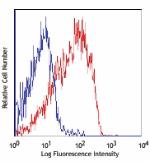
C57BL/6 mouse splenocytes were stained with CD62L (clone MEL... -
PerCP/Cyanine5.5 anti-mouse CD62L

C57BL/6 mouse splenocytes were stained with CD3e APC and CD6... -
PerCP anti-mouse CD62L
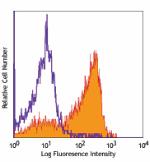
C57BL/6 mouse bone marrow cells were stained with CD62L (clo... -
Brilliant Violet 421™ anti-mouse CD62L

C57BL/6 mouse bone marrow cells were stained with CD62L (clo... -
Brilliant Violet 570™ anti-mouse CD62L
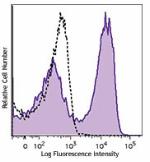
C57BL/6 mouse bone marrow cells were stained with CD62L (clo... -
Brilliant Violet 605™ anti-mouse CD62L
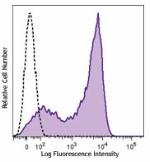
C57BL/6 mouse splenocytes cells were stained with CD62L (clo... -
Brilliant Violet 510™ anti-mouse CD62L

C57BL/6 mouse splenocytes were stained with CD3 APC and CD62... -
Purified anti-mouse CD62L (Maxpar® Ready)
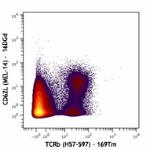
Mouse splenocytes stained with 169Tm-anti-TCRβ (H57-597) and... -
Brilliant Violet 711™ anti-mouse CD62L
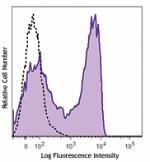
C57BL/6 mouse bone marrow cells were stained with CD62L (clo... -
Brilliant Violet 785™ anti-mouse CD62L
C57BL/6 mouse splenocytes were stained with CD3 FITC and CD6... -
PE/Dazzle™ 594 anti-mouse CD62L
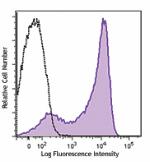
C57BL/6 mouse splenocytes were stained with CD62L (clone MEL... -
APC/Fire™ 750 anti-mouse CD62L
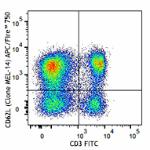
C57BL/6 mouse splenocytes were stained with CD3 FITC and CD... 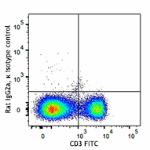
-
TotalSeq™-A0112 anti-mouse CD62L
-
Brilliant Violet 650™ anti-mouse CD62L

C57BL/6 mouse splenocytes were stained with CD3 FITC and CD6... -
TotalSeq™-C0112 anti-mouse CD62L
-
Ultra-LEAF™ Purified anti-mouse CD62L
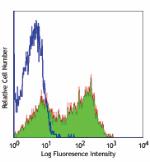
C57BL/6 mouse splenocytes were stained with Ultra-LEAF™ puri... -
KIRAVIA Blue 520™ anti-mouse CD62L

C57BL/6 mouse splenocytes were stained with CD3e APC and CD6... -
TotalSeq™-B0112 anti-mouse CD62L
-
Spark Red™ 718 anti-mouse CD62L (Flexi-Fluor™)

 Login / Register
Login / Register 












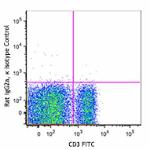







Follow Us